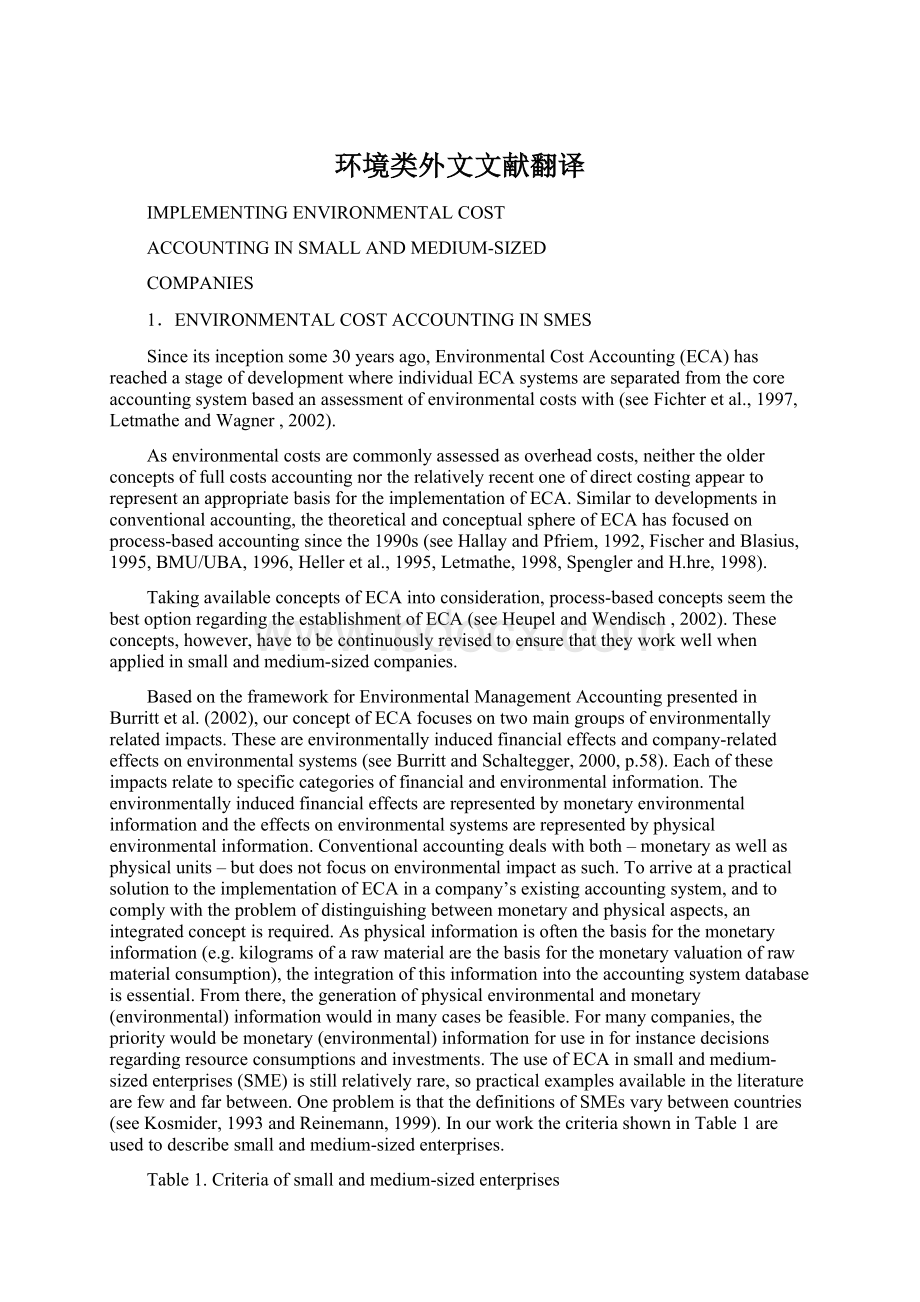 环境类外文文献翻译Word文档下载推荐.docx
环境类外文文献翻译Word文档下载推荐.docx
- 文档编号:18965755
- 上传时间:2023-01-02
- 格式:DOCX
- 页数:7
- 大小:23.69KB
环境类外文文献翻译Word文档下载推荐.docx
《环境类外文文献翻译Word文档下载推荐.docx》由会员分享,可在线阅读,更多相关《环境类外文文献翻译Word文档下载推荐.docx(7页珍藏版)》请在冰豆网上搜索。

1.ENVIRONMENTALCOSTACCOUNTINGINSMES
Sinceitsinceptionsome30yearsago,EnvironmentalCostAccounting(ECA)hasreachedastageofdevelopmentwhereindividualECAsystemsareseparatedfromthecoreaccountingsystembasedanassessmentofenvironmentalcostswith(seeFichteretal.,1997,LetmatheandWagner,2002).
Asenvironmentalcostsarecommonlyassessedasoverheadcosts,neithertheolderconceptsoffullcostsaccountingnortherelativelyrecentoneofdirectcostingappeartorepresentanappropriatebasisfortheimplementationofECA.Similartodevelopmentsinconventionalaccounting,thetheoreticalandconceptualsphereofECAhasfocusedonprocess-basedaccountingsincethe1990s(seeHallayandPfriem,1992,FischerandBlasius,1995,BMU/UBA,1996,Helleretal.,1995,Letmathe,1998,SpenglerandH.hre,1998).
TakingavailableconceptsofECAintoconsideration,process-basedconceptsseemthebestoptionregardingtheestablishmentofECA(seeHeupelandWendisch,2002).Theseconcepts,however,havetobecontinuouslyrevisedtoensurethattheyworkwellwhenappliedinsmallandmedium-sizedcompanies.
BasedontheframeworkforEnvironmentalManagementAccountingpresentedinBurrittetal.(2002),ourconceptofECAfocusesontwomaingroupsofenvironmentallyrelatedimpacts.Theseareenvironmentallyinducedfinancialeffectsandcompany-relatedeffectsonenvironmentalsystems(seeBurrittandSchaltegger,2000,p.58).Eachoftheseimpactsrelatetospecificcategoriesoffinancialandenvironmentalinformation.Theenvironmentallyinducedfinancialeffectsarerepresentedbymonetaryenvironmentalinformationandtheeffectsonenvironmentalsystemsarerepresentedbyphysicalenvironmentalinformation.Conventionalaccountingdealswithboth–monetaryaswellasphysicalunits–butdoesnotfocusonenvironmentalimpactassuch.ToarriveatapracticalsolutiontotheimplementationofECAinacompany’sexistingaccountingsystem,andtocomplywiththeproblemofdistinguishingbetweenmonetaryandphysicalaspects,anintegratedconceptisrequired.Asphysicalinformationisoftenthebasisforthemonetaryinformation(e.g.kilogramsofarawmaterialarethebasisforthemonetaryvaluationofrawmaterialconsumption),theintegrationofthisinformationintotheaccountingsystemdatabaseisessential.Fromthere,thegenerationofphysicalenvironmentalandmonetary(environmental)informationwouldinmanycasesbefeasible.Formanycompanies,theprioritywouldbemonetary(environmental)informationforuseinforinstancedecisionsregardingresourceconsumptionsandinvestments.TheuseofECAinsmallandmedium-sizedenterprises(SME)isstillrelativelyrare,sopracticalexamplesavailableintheliteraturearefewandfarbetween.OneproblemisthatthedefinitionsofSMEsvarybetweencountries(seeKosmider,1993andReinemann,1999).InourworkthecriteriashowninTable1areusedtodescribesmallandmedium-sizedenterprises.
Table1.Criteriaofsmallandmedium-sizedenterprises
NumberofemployeesTurnover
Upto500employeesTurnoveruptoEUR50m
ManagementOrganization
-Owner-cum-entrepreneur-Divisionalorganizationisrare
-Variesfromapatriarchalmanagement-Shortflowofinformationstyle
intraditionalcompaniesandteamwork-Strongpersonalcommitment
instart-upcompanies-Instructionandcontrollingwith
-Top-downplanninginoldcompaniesdirectpersonalcontact
-Delegationisrare
-Lowlevelofformality
-Highflexibility
FinancePersonnel
-familycompany-easytosurveynumberofemployees
-limitedpossibilitiesoffinancing-wideexpertise
-highsatisfactionofemployees
SupplychainInnovation
-closelyinvolvedinlocal-highpotentialofinnovation
economiccyclesinspecialfields
-intenserelationshipwithcustomers
andsuppliers
Keepingthesecharacteristicsinmind,thechosenECAapproachshouldbeeasytoapply,shouldfacilitatethehandlingofcomplexstructuresandatthesametimebesuitedtothespecialneedsofSMEs.
DespitetheirsizeSMEsareincreasinglyimplementingEnterpriseResourcePlanning(ERP)systemslikeSAPR/3,OracleandPeoplesoft.ERPsystemssupportbusinessprocessesacrossorganizational,temporalandgeographicalboundariesusingoneintegrateddatabase.TheprimaryuseofERPsystemsisforplanningandcontrollingproductionandadministrationprocessesofanenterprise.InSMEshowever,theyareoftenindividuallydesignedandthusnotstandardizedmakingtheintegrationofforinstancesoftwarethatsupportsECAimplementationproblematic.Examplescouldbetoolslikethe“eco-efficiency”approachofIMU(2003)orUmberto(2003)becausethesesolutionsworkwiththedatabaseofmorecomprehensivesoftwaresolutionslikeSAP,Oracle,Navisionorothers.Umbertosoftwareforexample(seeUmberto,2003)wouldrequirelargeinvestmentsandgreatbackgroundknowledgeofECA–whichisnotavailableinmostSMEs.
TheECAapproachsuggestedinthischapterisbasedonanintegrativesolution–meaningthatanindividuallydevelopeddatabaseisused,andtheECAsolutionadopteddrawsontheexistingcostaccountingproceduresinthecompany.IncontrasttootherECAapproaches,theaimwastocreateanaccountingsystemthatenablesthecompaniestoindividuallyobtaintherelevantcostinformation.Theaimoftheresearchwasthustofindoutwhatcostinformationisrelevantforthecompany’sdecisiononenvironmentalissuesandhowtoobtainit.
Phase1:
ProductionProcessVisualization
Atthebeginning,theprojectteammustbebriefedthoroughlyonthecurrentcorporatesituationandontheaccountingsituation.Tothisend,theexistingcorporateaccountingstructureandtherelatedcorporateinformationtransfershouldbeanalyzedthoroughly.Followingtheconceptofaninput/outputanalysis,howmaterialsfindtheirwaysintoandoutofthecompanyisassessed.Thenextstepistopresenttheflowofmaterialandgoodsdiscoveredandassessedinaflowmodel.Toensurethecompletenessandintegrityofsuchasystematicanalysis,anyinputandoutputistobetakenintoconsideration.Onlyadetailedanalysisofmaterialandenergyflowsfromthepointtheyenterthecompanyuntiltheyleaveitasproducts,waste,wastewateroremissionsenablesthecompanytodetectcost-savingpotentialsthatatlaterstagesoftheprojectmayinvolvemoreefficientmaterialuse,advancedprocessreliabilityandoverview,improvedcapacityloads,reducedwastedisposalcosts,bettertransparencyofcostsandmorereliableassessmentoflegalissues.Asafirstapproach,simplifiedcorporateflowmodels,standardizedstand-alonemodelsforsupplier(s),warehouseandisolatedproductionsegmentswereestablishedandonlycombinedaftercompletion.Withsuchstandardelementsandprototypesdefined,acompanycanreadilydevelopanintegratedflowmodelwithproductionprocess(es),productionlinesoraproductionprocessasawhole.FromtheviewoflateradoptionoftheexistingcorporateaccountingtoECA,suchvisualizationhelpsdetect,determine,assessandthenseparateprimaryfromsecondaryprocesses.
Phase2:
ModificationofAccounting
Inadditiontothevisualizationofmaterialandenergyflows,modelingprincipalandperipheralcorporateprocesseshelpspreventproblemsinvolvingtoohighsharesofoverheadcostsonthenetproductresult.Theflowmodelallowsprocessestobedetermineddirectlyoratleastpartiallyidentifiedascostdrivers.Thisallowsidentifyingandseparatingrepetitiveprocessingactivitywithcomparablyfewoptionsfromthosewithmorelikelyonesforpotentialimprovement.
Byfocusingonprincipalissuesofcorporatecostprioritiesandonthosecoststhathavebeenassessedandassignedtotheircausesleastappropriatelysofar,corporateproceduressuchaspreparingbids,settingupproductionmachinery,ordering(raw)materialandrelatedprocessparameterssuchasorderpositions,settingupcyclesofmachinery,andorderitemscanbedefinedaccurately.Puttingseveralpartialprocesseswiththeirisolatedcostsintocontextallowsprincipalprocessestoemerge;
theseformthebasisofprocess-orientedaccounting.Ultimately,thecostdriversoftheprocessesassessedaretheactualreferencepointsforassigningandaccountingoverheadcosts.Thepercentagesurchargesoncostssuchaslaborcostsarereplacedbyprocessparametersmeasuringefficiency(seeFosterandGupta,1990).
Somecorporateprocessessuchasmanagement,controllingandpersonnelremaininadequatelyassessedwithcostdriversassignedtoproduct-relatedcostaccounting.Therefore,costsoftheprocessesmentioned,irrelevanttothemeasureofproductionactivity,havetobeassessedandsurchargedwithaconventionalpercentage.
Atmanufacturingcompaniesparticipatingintheproject,computer-integratedmanufacturingsystemsallowamoreflexibleandscope-orientedproduction(eco-moniesofscope),whereasbeforeonlyhomogenousquantities(ofproducts)couldbeproducedunderreasonableeconomicconditions(economiesofscale).ECAinevitablypreventseffectsofallocation,complexityanddigressionandbecomesavaluablecontrollinginstrumentwhereclassical/conventionalaccountingarrangementssystematicallyfailtofacilitateproperdecisions.
Thus,individuallyadoptedprocess-basedaccountingproducespotentiallyvaluableinformationforanykindofdecisionaboutinternalprocessingorexternalsourcing(e.g.make-or-buydecisions).
Phase3:
HarmonizationofCorporateData–CompilingandAcquisition
Onthewaytoatransparentandsystematicinformationsystem,itisconvenient
- 配套讲稿:
如PPT文件的首页显示word图标,表示该PPT已包含配套word讲稿。双击word图标可打开word文档。
- 特殊限制:
部分文档作品中含有的国旗、国徽等图片,仅作为作品整体效果示例展示,禁止商用。设计者仅对作品中独创性部分享有著作权。
- 关 键 词:
- 环境 外文 文献 翻译
 冰豆网所有资源均是用户自行上传分享,仅供网友学习交流,未经上传用户书面授权,请勿作他用。
冰豆网所有资源均是用户自行上传分享,仅供网友学习交流,未经上传用户书面授权,请勿作他用。


 铝散热器项目年度预算报告.docx
铝散热器项目年度预算报告.docx
